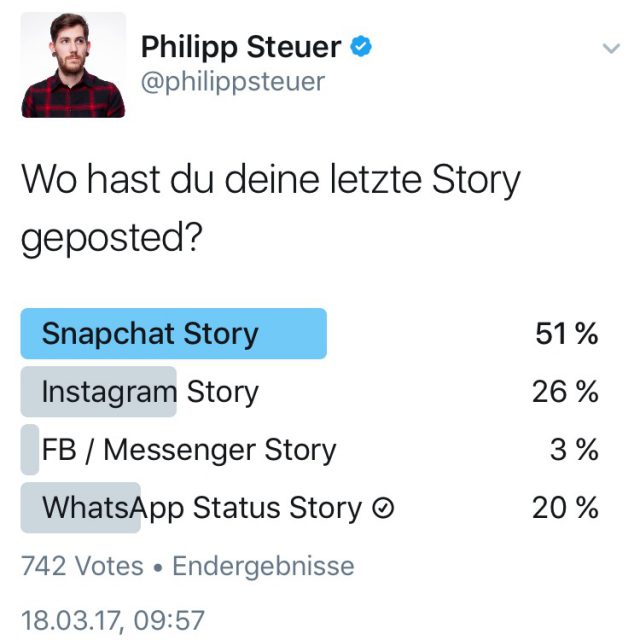Day and Status – We Share Stories with Friends
After Instagram Stories, Facebook continues its attack on Snapchat, implementing similar formats on WhatsApp and Messenger.
What effect will this have on our communication?
Now also Messenger (day) and WhatsApp (status) — Facebook is apparently thinking, “If we can’t buy Snapchat, we’ll simply copy its success formula and enable storytelling on our channels.” It’s already working on Instagram…
So what does this mean for businesses?
First of all, it means that the social media element that cannot be effectively measured — the so-called dark social — will expand. Granted, one-on-one communication existed already in the SMS era; nonetheless, the update of the Facebook networks represents a caesura.
The new story formats are predestined as platforms for customers to report their experiences with brands and products — with the experience of sharing privately, in small groups and with one’s direct contacts. Thus a new communication channel emerges; one that is immune to access by corporations. Everyone has the capability of becoming a peer influencer.
How are stories received?
Storytelling formats will undoubtedly change the way we communicate. The only question is when this will happen. Now that WhatsApp and Facebook — the two largest platforms — have adopted the technology, all of Germany could begin telling stories. Theoretically.
It remains to be seen how the over-40 crowd that is already making extensive use of Facebook and WhatsApp will respond. Contrary to Generation Z, to whom Snapchat owes its success, the more mature group was socialised with other values. They are not quite as response-driven as teens and twenty-somethings. Attention is not so much an end in itself as it is a means to (traditional monetary) success.
 In line with this theme, Snapchat expert Philipp Steuer launched a Twitter survey. Due to his focus on Snapchat, his followers naturally use the app disproportionately. Nonetheless, it is interesting to discover that the story platforms that are most used are the ones that have been on the market the longest, rather than those with the highest number of users.
In line with this theme, Snapchat expert Philipp Steuer launched a Twitter survey. Due to his focus on Snapchat, his followers naturally use the app disproportionately. Nonetheless, it is interesting to discover that the story platforms that are most used are the ones that have been on the market the longest, rather than those with the highest number of users.
Having said that, it will certainly be interesting to ask this question again once people other than heavy users and social media managers have become familiar with these functions. If we were then to add a clustering by age, companies would be able to assess the status of their own communication: is it the eleventh hour, or already past midnight?
What can communicators do?
Here’s one tip: read “Lotsen in der Informationsflut” (Navigating the Information Flood) by Dr Kerstin Hoffmann. In this book, Dr Hoffmann clearly describes how employees can become brand ambassadors and reach stakeholders through dialogue, where social media intentionally sets technological borders.
Or how to start one step earlier with something that’s older than social media or the Internet, namely your own values. Not until a company has clearly defined their values, and created a value proposition, can employees orient themselves on them. This is by no means a new concept — on the contrary, it is quite dated. In practice, however, it receives less attention than short-term sales campaigns. It is not enough for a company to simply define its values once. These values must also be strictly adhered to, whether in product development or other departments.
Anyone who is not yet familiar with the meanwhile legendary video by Simon Sinek should take a few minutes to watch it.
 Click to load the video. Personal data will be shared with the hoster - Privacy Policy
Click to load the video. Personal data will be shared with the hoster - Privacy Policy
In it, he explains what makes Apple so special. When a company’s WHY is lived in all departments, a homogenous image is automatically generated for consumers. Regardless whether product development, sales, customer service or marketing — a fixed rule provides orientation and facilitates successful leadership. Simultaneously, these guard rails open the door to spontaneous yet brand-oriented campaigns, which become increasingly critical in times of short attention spans and smartphone-armed consumers.
Take the case of a snowstorm, for example. One such event was used by Under Armour to fulfil on the central brand promise: “We help athletes become better”.
Instead of advertising their products on billboards along a running course, the Americans let actions speak. In the morning after a snowfall, Under Armour took advantage of the opportunity and cleared paths for joggers, helping the athletes achieve their best performance.
Brand values became reality through an extraordinary service. And in a manner that inspired people to retell it — as a story, no matter which platform they used.
André Karkalis is Managing Director at KARKALIS COMMUNICATIONS. Sometimes he writes about topics that move him. Generally, from his armchair in the agency kitchen. This is where his Kitchen Post is created.